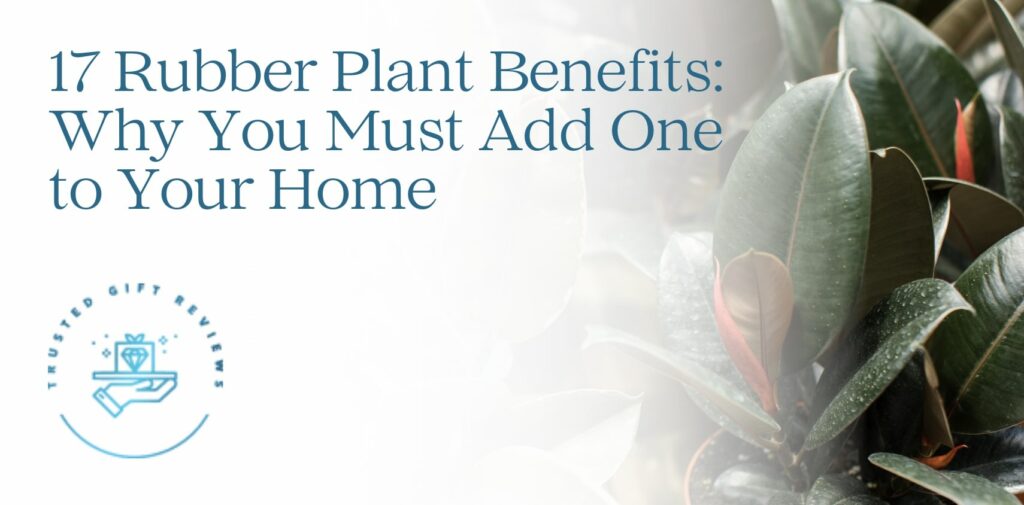Rubber plants are one of the most well-liked indoor plants. They’re known for their stylish, large, and glossy leaves, hardiness, and ease of care.
Still, if you are in doubt about whether or not to add one to your home, allow us to list down its bevy of benefits in this reliable quick guide today.
Further on, we will zero in on how to take care of rubber plants properly so they stay vigorous and grand year after year.
Rubber Plant Basic Info


Genus: Ficus
Family: Moraceae
Mature height: Up to 10 feet indoors and 50 feet outdoors
Growing season: Summer
Physical characteristics: Big, leather-like, and glowing leaves; aerial or buttress roots
Native habitat: South and Southeast Asia, Florida, West Indies, and Sri Lanka
Colors: Dark green or crimson hues with cream, pink, or white
The rubber plant or tree (Ficus elastica) is a fantastic houseplant that can grow up to 10 feet tall indoors.
In contrast, it can grow up to a towering 50 feet outdoors like in its home in South and Southeast Asia.
It’s part of the large family of Moraceae, which includes the mulberry, jackfruit, breadfruit, and banyan fig.
Rubber plants are grown for their big, leather-like leaves. These leaves are oval or oblong in shape and sport dark green or crimson hues with cream, pink, or white.
And here’s an interesting fact about outdoor rubber trees: they bear light yellow or green flowers and faux oval figs that the fig wasp pollinate. These things make them unique from other flowering plants.
What are the benefits of rubber plants?


The rubber plant offers a slew of benefits:
- Air purification
- Easy to maintain
- Easy to propagate
- Brings good luck
- Treats skin inflammation
- Decreases stress
1) Grows Large and Beautiful Leaves
Rubber trees grow large, glossy, and beautiful foliage easily, making them a center of attraction in your living space.
In fact, their leaves are some of the largest there are for houseplants, measuring about 18 inches long.
Best of all, they differ in tone depending on the species. Most of them are shadowed in black, while some have cream yellow, pink, or red on the margins.
2) Purifies the Air
Rubber plants have also been proven to be one of the indoor plants that remarkably cleanse the air. A study conducted by NASA confirmed this.
They can filter or eliminate harmful airborne chemicals, remove up to 60 percent of fungal spores and bacteria in the air and increase the production of oxygen.
Plus, it neutralizes formaldehyde found in the air. This chemical causes a variety of health symptoms including burning eyes, sore throat, coughing, and wheezing.
It does all these as a defense mechanism for its soil health and survival. As a result, you will live and feel healthier and sleep better in your crib with this plant.
3) Combats Climate Change


Like all plants, rubber plants can help the Earth cool down and have more oxygen for us to breathe. Though in a very small way, planting one plant or tree contributes to the healing of the planet from the dire effects of climate change.
4) Easy to Maintain
It’s very easy to take care of a rubber plant. These plants only need plenty of sun, slightly damp soil, and room ambient temperature.
If you keep them away from dangerous pests like spider mites, scales, and mealybugs, these magnificent plants should grow wonderfully and rapidly inside your house.
5) Resists Dry Spells
It’s hard to bring the rubber tree down. It has a natural tremendous resistance to wet and dry environments alike.
Similar to snake plants, when a rubber plant is established in its soil, it becomes drought-tolerant. So, even if you forget to water it, its leaves will retain their beauty and luster for a certain period.
Furthermore, they won’t curl up or yellow as a reaction to getting insufficient watering. Even so, as soon as you remember, you must water the rubber tree as it needs.
6) Requires No Fertilization
On its own, the rubber plant can grow normally and develop amazing, healthy leaves and stems. It doesn’t require being fed with fertilizer throughout its life at all.
However, it will not grow as lush and full without plant food. As such, if you want it to reach its full potential, then you have to give it fertilizer, preferably one that has higher nitrogen.
Speaking of nitrogen, it’s very beneficial for the plant’s health and growth, being responsible for the plant to produce chlorophyll and amino acids, which are the building blocks of their proteins.
7) Easy to Propagate
Unlike other plants, rubber trees are incredibly easy to propagate and have a high success rate of living through and after this process.
So this means that you can have more of them without needing to pick up new sets of young plants from the store, saving you money.
How do you propagate rubber plants?
Follow the steps required for breeding your rubber plant below:
- Snip a 15-cm part of the mother rubber tree that can either be the stem or preferably, the tips.
- Remove each leaf of the baby plant and wash it till you see the sap come out.
- Plant the washed stem or tips in a new pot with fresh potting soil.
- Place the potted cutting in a warmer spot than where it’s previously been kept.
8) Affordable
We don’t think you’re going to have any trouble finding and affording rubber trees because many nursery and flower shops have them and the plant is inexpensive, unlike monsteras and philodendrons.
If you don’t want to buy more rubber plants because you’re cost-cutting, you can just propagate the parent rubber plant. Doing so will give you more of them for your valued garden.
9) Fits Large Spaces
Is your house interior spacious? Then you can fill its spaces with a potted rubber plant that can grow upwards fairly quickly.
Its presence can make the room atmosphere serene and calm while making you feel you’re in a tropical paradise.
You can even place them outside on the porch or deck to greet guests if the weather is consistently cool. It will add some sort of positive charm to your house that people can appreciate.
10) Stops Skin Inflammation
One of the great benefits of rubber plant is it has an anti-inflammatory quality. So, if you have a wound, rash, or allergy, get one or two fresh rubber plant leaves and crush them into tiny pieces using a mortar and pestle.
Then, rub these small pieces onto your rash to soothe and treat it. It should lessen or go away in a few days or more.
11) Relieves Tooth or Gum Pain
According to medical research, rubber trees are believed to act as a natural analgesic to relieve tooth and gum pain and inflammation.
To treat your aching teeth or gums, simmer the mashed rubber plant leaves in a glass for a few minutes and gargle the mixture.
12) Promotes a Healthy Stomach


While there isn’t enough scientific evidence yet, it’s said that a rubber plant can help promote a healthy stomach.
Many people in rural areas actually use rubber plant leaves to alleviate stomachaches, indigestion, and diarrhea.
In addition, the rubber plant is used as a traditional medicine in order to cure stomach ulcers and abscesses. Abscess, by the way, is infected pus around swollen tissues inside the stomach.
To heal both of them, you’ll have to take the rubber plant’s roots and clean them before mashing them. Then apply this mixture externally on the affected area.
Alternatively, you can create a stomach ulcer medicinal brew by obtaining 35 grams of rubber plant roots and brewing them in two glasses of hot water. Drink the mixture twice a day in the morning and afternoon.
13) Regulates Menstrual Period


Some women experience an irregular menstrual period due to genetics, certain health conditions, or their lifestyle and exercise habits.
Luckily, rubber plant leaves, either applied as a topical treatment or brewed in hot water and drank, will help them to get a regular period and fight off the uneasy feelings related to menstruation.
14) Helps with Premenstrual Syndrome
Aside from wounds, cuts, and dental pain, the rubber plant can also ease premenstrual syndrome in women.
The associated symptoms can be food cravings, irritability, fatigue, depression, mood changes, and pain-sensitive breasts. Used as a natural analgesic, the rubber plant can mitigate one or more of these symptoms.
15) Lucky for Feng Shui


Feng shui has a way of interpreting or relating a thing’s appearance with luck. In the case of rubber plants, feng shui practitioners say that they symbolize riches and fortune because their leaves are shaped like coins and these are thick and fleshy.
In certain areas of the home, the houseplant is said to counter the torrent of negative energy with its positive qualities. That’s why it’s commonly given as a housewarming gift.
Whereas, in the office, it’s said to suggest the success of a business venture with its attractive leaves. It may also boost the person’s creativity and abundance as well as harmony with their co-workers.
16) Reduces Stress
When stress hinders us from doing our daily tasks, having indoor plants like the rubber plant can provide a little relief.
Having a little piece of nature at home can ground us and let us get in touch with our feelings and thoughts, which will then help us act in the best way.
It will also give us the much-needed physical and mental boost or “second wind” to achieve what we set out to do, as per the findings of the Journal of Physical Anthropology.
17) Improves Memory and Concentration
A study conducted by Exeter University points out that having indoor plants like rubber plants nearby increases productivity, concentration, and well-being at the workplace.
They also specified that this can boost one’s memory by up to 20 percent!
But we think that the practical reason is that plants can soothe people, making them more efficient at work.
How do you care for a rubber plant?


To take care of a rubber plant properly, you have to give it moist soil, expose it to sunlight for six to eight hours every day, and water it once or twice weekly.
Sunlight
You must give the rubber plant access to bright, indirect or shaded light six to eight hours every day.
Note that placing them where they get direct sunlight will singe their leaves. So, remember to put them 4 to 5 feet away from the window.
Soil
The rubber plant thrives in fertile and moist soil, but make sure that the soil isn’t soaked. This ideal potting soil can be achieved with this recipe: 1 part peat, 1 part sand, and 1 part pine bark.
Plus, the soil has to be lightly acidic to neutral, staying within the pH range of 5.5 to 7.0 because this dictates how much nutrients they’re going to get from the soil.
Watering


Rubber plants need to be watered once or twice weekly. Let their soil dry out first between waterings.
If they receive more hot sun during spring or summer, water them more often. But on cooler days in autumn and winter, water them less to prevent the soil from being sodden.
Temperature and Moisture
The preferred temperatures of rubber plants are 75℉ to 80℉ in the morning and 60℉ to 65℉ at night.
Refrain from suddenly placing them in cold or drafty locations—one that drops below 55℉. Otherwise, their growth will be affected.
With regard to moisture, it needs one at a high level, though you don’t have to set your home at 80 percent to 90 percent relative humidity.
You can just mist the rubber plant’s leaves with clean water if they have become dry.
Pruning
Trimming the rubber plant’s leaves and stems is done to keep it clean and promote new, fresher growth.
While you can do it anytime in the year, it’s best done in spring or summer so growing new leaves won’t be difficult for the plant.
But keep in mind to snip parts only above a node. A node is a tiny branch bearing leaves that are attached to the stem.
Also, take care not to remove all the foliage, the most you can do is take out or prune 1/2 to 1/3 of the plant’s branches.
Fertilizing


Apply fertilizer to the rubber plant once every two weeks during the summer, when it is actively growing.
Ideally, provide it with plant food with an NPK ratio of 24:8:16 for rich and bushy growth. But you can choose one with a different balance depending on the amount of sunlight the plant gets.




